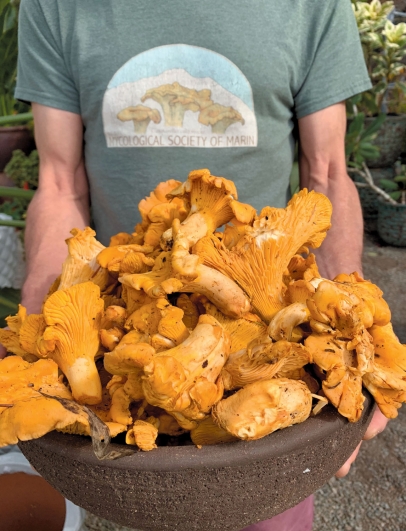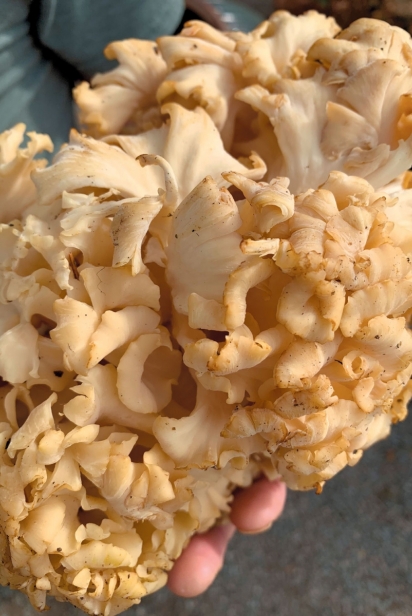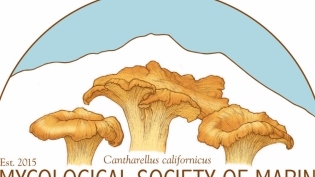Mushroom Mania
INTEREST IN FORAGED FUNGI IS POPPING UP ALL OVER
They are fungi that have fascinated the world over. And nowadays, they are spawning unprecedented interest— for a host of new reasons.
Mushrooms are having a major moment.
As foodstuff, they may be irresistible in stroganoff, ragu, pizza and classic beef Wellington. But in the future, these multicellular organisms that pop up in the wilds in cold, damp weather also may hold vital keys to developing new sustainable clothing materials, safer housing and more effective treatments for illnesses.
“Human beings should pay attention when nature provides great things like this,” says Philip Ross, a visiting scholar at Stanford University’s Department of Bioengineering and founder of MycoWorks, a San Francisco start-up that creates environmentally friendly building materials out of mushrooms.
There’s no better time to do so than now. Get to know the latest and greatest about mushrooms at “Wild in Marin,” the first fungus festival hosted by the Mycological Society of Marin, taking place January 5 at the Mill Valley Golf Course clubhouse in Marin County. Among the highlights will be a woodland display that an army of volunteers will create overnight after foraging for about 300 different species of wild mushrooms.
“Mushrooms are always fascinating to look at,” says Kevin Sadlier, who founded Myco Marin, as the nonprofit is better known, in 2015. “They stir a curiosity. And foraging stimulates something deep inside—the hunter-gatherer in all of us.”
Interest is only bound to grow as more of their hidden potential is unlocked, too. Just consider what Ross’s company, MycoWorks, has already developed since its founding in 2013. A former forager, Ross discovered a way to grow reishi mushrooms so that their mass of tiny root fibers, or mycelium, grows tightly together in sawdust, forming natural polymers that adhere like glue.
MycoWorks has fashioned that resulting material into buoys that float on water and even bricks sturdy enough to construct a tea house in Germany. Because the mushroom material also is fire resistant and has vibration-dampening qualities, it could prove useful in earthquake-prone areas. Most recently, the company also has used mycelium to engineer animal-free leather as durable as the real deal.
“People think it’s so strange when they first hear about it,” Ross says.
“But when they see it, their minds explode with the possibilities.”
Mushrooms have long been valued by various cultures for their purported medicinal properties. In summer 2018, they took an even bigger step toward mainstream legitimacy when the U.S. Food and Drug Administration approved the first clinical trial in this country of the use of psilocybin, the psychedelic ingredient in “magic mushrooms,” to treat depression. The FDA gave the go-ahead to London-based Compass Pathways, the health and life sciences start-up backed by venture capitalist and PayPal co-founder Peter Thiel.
In How to Change Your Mind (Penguin Press, 2018) the 2018 bestseller about the new science of psychedelics, UC Berkeley journalism professor, author and food activist Michael Pollan recounts how small trials on cancer patients at New York University and Johns Hopkins University have already shown significant reductions in standard measures of anxiety and depression through the use of psychedelics. Pollan, who declined to be interviewed, also writes in the book of his own experiences in drinking psychedelic mushroom tea and ingesting actual mushrooms with a guide. He found that psilocybin causes the sense of ego to disappear temporarily, allowing for expansive new thoughts and perspectives.
It’s conceivable that magic mushrooms might someday follow the arc of marijuana—going from a fringe, once completely illegal substance used primarily to get a recreational high, to an accepted, effective therapeutic aid when consumed in controlled amounts. When you realize that there are probably between 2.2 to 3.8 million species of fungi in the world, with only 120,000 named so far, according to the American Society for Microbiology, the potential uses for mushrooms could prove dramatic.
“It’s a very exciting time,” Sadlier says. “We’re taking away the sensationalism of mushrooms. We’re not looking at them for intoxication purposes but for microdoses that can have a real benefit.”
While Sadlier admits he experimented with psychedelic mushrooms when he was younger, he’s far more interested in the culinary ones now, particularly in the hunt for them. He thinks nothing of driving for hours to forage, even if there are no guarantees he won’t come up empty-handed.
Every fall for many years now, prior to the start of California’s mushroom season, he’ll make the 10-hour drive to Oregon two or three times to trudge off the beaten path through mud and muck to search for specific trees that have a symbiotic relationship with certain mushrooms, such as pines with porcini and oaks with chanterelles.
About two weeks after the first two inches of rain fall on the Bay Area, mushrooms will start popping up locally. First, meaty porcinis, then black trumpets, followed by hedgehogs and then yellowfoot chanterelles. Golden chanterelles, with their apricot-like flavor, grow throughout the winter season. In January, it’s time for candy caps with the beguiling taste of maple syrup. Although there is no known mushroom endemic solely to Marin County, Sadlier says, there are some such as the candy cap that aren’t found anywhere else except in the region stretching from San Luis Obispo up to Northern California. In spring, Sadlier heads to the Sierras to hunt for morels, then porcinis. “Then, we wait for the cycle to start all over again,” he says with an air of practiced patience.
A former executive chef who now owns Green Jeans Garden Supply in Mill Valley with his wife, Xander Wessells, Sadlier uses most of his mushroom bounty for bartering—for wine at Honig Vineyards and tequila from rock legend and Mill Valley resident Sammy Hagar.
He also trades mushrooms for meals at Quince in San Francisco, Picco in Larkspur and Mill Valley Beerworks. He still gets a kick whenever his name is listed as a purveyor on their menus.
“As a former chef, I know how to find my way to the back door of the kitchen,” he says. “Early on, I learned that when I brought in a box of beautiful porcinis, and a chef would sniff them and ask how much they were, that he didn’t really know what they were. So, I’d back out until I found a chef who would go, ‘Wow!’ Those are the chefs who know what to do with them and how to treat them.”
Sadlier doesn’t have the opportunity to barter as much as he once did, though, because climate change has caused a slow decline in mushroom populations. Sudden oak death has felled oaks, and thus diminished the habitat of chanterelles and black trumpets. California’s five-year drought also took a toll. Whereas Sadlier used to gather about 40 pounds of mushrooms in one outing, nowadays he’s lucky to get 10 pounds.
Still, when he can, he keeps a cooler stocked with mushrooms at Green Jeans—but only for select customers. “If I hear a customer with an Eastern European accent, I’ll show them my stash, and they’ll start reminiscing about foraging in Romania with their grandfather,” Sadlier says. “Or if I spot a Japanese customer and I have matsutakes, I’ll bring them out. But if I don’t really know a person, I won’t approach them. Most would just go, “Oh my god, aren’t they poisonous?’“
Certainly due diligence should always be exercised when it comes to wild mushrooms. In fact, during the rainy season, Sadlier will field about three calls or texts a day from people returning from a hike, concerned that their dog has eaten a wild mushroom.
Mushrooms have captured Sadlier’s fancy ever since he took a mushroom identification class 23 years ago to learn how to forage in order to cook with them more economically. He volunteered for years at the Mycological Society of San Francisco, but the drive over the bridge, coupled with running a business and raising his children, became too taxing, so he quit. He soon regretted it. So in 2015, he decided to start a mycological society in Marin, which didn’t have one yet.
Myco Marin now has more than 100 members, most from Marin County, including some who belong to multiple mycological societies. The San Francisco society is largely made up of hipsters and grad students, Sadlier jokes, while the Marin group is full of retirees.
“There’s been a ton of interest here. A lot of people have come up to us saying how glad they are that we started this,” says Kristine Ball, president of Myco Marin, and former director of development for the Marin Agricultural Land Trust, who has been an avid forager for 15 years, ever since her daughter’s school project prompted them to go looking for wild mushrooms for her to draw.
Once a month, from October through April, the Marin society leads popular mushroom forays. It also hosts workshops and a free speakers series. Additionally, it just created a public mushroom garden at the Mill Valley Library, where large vertical logs were inoculated with five types of mushrooms. When the mushrooms sprout, which could take up to a year, it will be a living, regenerating display to educate kids and adults alike.
It’s hard to think of another food that has so many potential uses. Mushrooms are a nutritional powerhouse rich in B vitamins and antioxidants. They also keep forests healthy by eating away decay and can help clean up environmental pollutants such as petroleum spills. Could they possibly cure all the ills plaguing the planet?
“They could bring world peace,” Sadlier says with a smile. “Especially with the notion of microdosing.”
The wide world of mushrooms continues to grow ever more magical—in many more ways than one.








